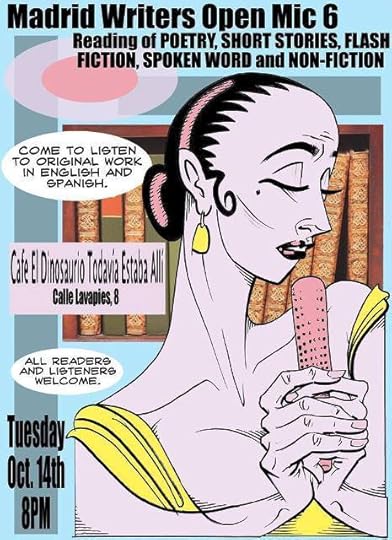Sue Burke's Blog, page 65
November 12, 2014
Self-publishing, 400 years ago
Self-publishing is nothing new – and neither is piracy. The first book of Don Quixote by Miguel de Cervantes was published in Madrid and was immediately pirated in Lisbon.
Then as now, payment by publishers to authors was low, and so just like today, some authors were willing to get their book printed and sell it themselves, but it has always been a lot easier to get a book printed than to sell it. In Don Quixote, Book II, Chapter LXII, published in 1615, our mad knight-errant meets an even madder author in a printing shop in Barcelona and has this conversation:
"I would venture to swear," said Don Quixote, "that you, sir, are not known in the world, which always begrudges its reward to rare wits and praiseworthy labors. What talents lie wasted there! What genius thrust away into corners! What worth left neglected!... But tell me, sir, are you printing this book at your own risk, or have you sold the copyright to some bookseller?"
"I print at my own risk," said the author, "and I expect to make at least a thousand ducados* with this first edition, which is to be of two thousand copies that should sell in the blink of an eye at six reales** apiece."
"A fine calculation you’re making!" said Don Quixote. "It seems you don't know the ins and outs of the printers, and the false accounting that some of them use. I promise you when you find yourself weighed down with two thousand copies, you will feel so careworn that it will astonish you, particularly if the book is unusual and not at all humorous."
"Then what!" said the author. "Sir, do you wish me to give it to a bookseller who will give three maravedís*** for the copyright and think he is doing me a favor? I do not print my books to win fame in the world, for I am already well-known by my works. I want to get something out of it, otherwise fame is not worth a cuatrín****."
---
*1,000 ducados, in today’s prices and currencies, might equal roughly €28,125 or US$35,600. By comparison, Cervantes may have received about 100 to 125 ducados for the first book of Don Quixote. The contract has been lost, but that price is in keeping with what he made for other books.
**6 reales, in today’s equivalent currencies, might be about €15.35 or US$19.43. The first book of Don Quixote sold for 290.5 maravedís, or about €21.78 or US$27.57.
***About €0.23 or US$0.28 – we could translate it into American English as a “quarter.”
****A coin worth so little that no one recalls its value anymore. We could translate it as a “penny” or “farthing” and probably be close to the original meaning.
— Sue Burke
A more detailed analysis of how little Cervantes made from Don Quixote is available here:
http://amadisofgaul.blogspot.com.es/2010/12/whats-masterpiece-worth.html
November 5, 2014
Adolescents confront history
Oh, no! Why?
The answer involved a history lesson. The swastika symbol was old, older than Nazis and World War II. Nazis didn’t invent it, they only used it. Our building was older than the Nazis, so when it was built, the ancient symbol had seemed innocent, just like the lions and anchors.
We learned a lot in those buildings. In my case, classes included Spanish, algebra, geometry, civics, literature, art, home economics, and gym. But in the hallways, thanks to that scandalous tile, we also learned a lesson about the world, an idea some adults still don’t quite get. Things change over time, and the past holds surprises.
We also wondered why we were attending such old, decrepit buildings. This wasn’t just us kids whining, since teachers and parents had the same question. At some point – I can’t find out exactly when – the buildings were torn down and replaced by a new middle school elsewhere in the city.

My old junior high school was so unloved that I cannot find a single photo of the buildings on the Internet. All I could find were tiles in the Men’s Gymnasium, built in 1917, at Indiana University. They seem to have come from the same manufacturer as the ones at my junior high school.
The tiled floor at my school with the swastika has disappeared. It became history, a memory with a lesson.
And the world keeps changing.
— Sue Burke
Also posted at my professional website,
October 29, 2014
Birds on Earth

I am a total Earthling. By that I mean I am entirely used to this planet’s environment.
Here’s a small example:
One day I was out on my morning walk, and up ahead a wood pigeon sprang into the air and started flying toward me. With a 30-inch wingspan, it’s a fairly big bird. But I didn’t flinch. I knew that the bird, very common in my neighborhood, had no interest in messing with me. It would swerve with plenty of time.
Think of all the other potentially scary if not genuinely dangerous natural wonders we encounter on a normal day, such as a bee, dog, or cactus – to say nothing of technology.
Right now I’m writing a novel about Earthlings on another planet. How can they know if what looks like a bird or a mere stick of wood is really harmless? Well, they can’t, and not all of them are as brave as they need to be.
— Sue Burke
October 22, 2014
Go Ahead — Write This Story: Change, Part III
1. Many stories, especially television series, movies, and adventure novels, involve situational change: James Bond has a new adventure, or Bart Simpson overcomes a school bully.
2. In most novels and stories, characters change in small or large ways (or stalwartly resist change), such as Scrooge’s transformation in A Christmas Carol. This change must be permanent, and it must be dramatized.
3. Fiction sometimes tries to change the reader, the way Uncle Tom’s Cabin galvanized anti-slavery sentiment. Today, literary fiction often attempts this, usually a bit more subtly and directed at individuals rather than at society as a whole.
If you want to write about change, here are a few story ideas:
• This is an ecological thriller about a university microbiology student who decides to poke around the local Superfund pollution site to see what’s there – and gets lucky, if you could call it that.
• This a story about someone who seems to develop multiple personality disorder but in fact the new personality is a refugee from another space, time, and reality.
• This picaresque novel follows a young man who moves from job to job, such as Walmart clerking, Amazon warehouse order preparation, interstellar passenger ship cleaning, and zombie reburial, illustrating the brutal life of service workers.
— Sue Burke
October 21, 2014
"Summer Home" in the December Asimov's

Although my name isn't on the cover, I'm in there on pages 66 to 67: a very short story called "Summer Home."
October 18, 2014
Ortega y Gasset and his circumstances

“I am myself and my circumstances...”
If you know nothing else about José Ortega y Gasset, remember that phrase, his most famous, written in 1914. The Spanish philosopher died in Madrid on October 18, 1955, at age 72. He was active in the Second Republic and went into self-exile at the outbreak of the Civil War, although after 1945 he returned frequently to Spain.
For him, “Yo soy yo y mi circunstancia” expressed the constant conflict between every person and the time and place where he or she is born: the drama or tragedy between necessity and freedom, of living with a reality that “forms the other half of myself.”
For him, freedom meant “being free inside of a given fate,” with a necessity to act. “I am myself and my circumstances, and if I do not rescue my circumstances, I do not rescue myself,” he wrote. “Life is what we do and what happens to us.”
Within fate, we can choose our destiny and create “a project of life.”
Some may find their philosophy of life in religion, existentialism, or nihilism. He created a philosophy based on pragmatism.
“Living is a constant process of deciding what we are going to do.”
What are you going to do?
— Sue Burke
October 13, 2014
Open mic Tuesday

I’ll be at an open mic Tuesday, October 14, at 8:00 p.m. at El dinosaurio todavía estaba allí Bookstore and Café, calle Lavapiés, 8. Madrid.
I’ll be reading about what would happen if I were a plant. If you want to read, you can. Scripts, fiction, short stories, flash fiction, literary essays, poetry are welcome... in English, of course. There is a maximum reading time of 4 minutes.
It’s organized by the Madrid Writers Club. If you’re in town, I hope you can come!
— Sue Burke
Poster by Lance Tooks.
October 6, 2014
“Game of Thrones” made in Spain
We know what the residents of Game of Throne’s Kingdom of Dorne look like: tan and slim, but no tattoos. The women have long dark hair and the men have beards.
In fact, they look like a select sample of the residents of Osuna, Spain, a small town near Seville. The television series producers held a casting call there on September 2, accepting 500 of the 4,500 who came to the town’s soccer stadium for pre-selection.
Shooting begins today and will continue through October 29, and the extras will get €50 per day for working from 4 a.m. to 8:30 p.m., including the time in makeup, hairdressing, and wardrobe, although some may appear on-screen nude. Featured sites may include the local quarry, bullring, and Renaissance chapel.
Osuna Mayor Rosario Andújar expects it to be an enormous boost to the local economy, both during the filming and afterwards as a tourist attraction for fans. The municipal website already has pages dedicated to Juego de Tronos (Game of Thrones).
Some scenes will also be shot in the Royal Palace in Seville, one of my favorite places, sort of a mini-Alhambra. Dorne should be a stunningly beautiful kingdom.
— Sue Burke
October 1, 2014
Dad’s three rules for success
From the comfort of a bar stool, he told me three secrets to success at work – and he’d had a variety of experiences in life. I’ve tried to carry them out, and they work:
1. Always stay as polite as you can for as long as you can. If you start out mad, where can you go from there? Besides, if you’re polite, calm, and rational, the person you’re dealing with will feel obliged to act that way, too, and this is more likely to get you want you want.
My dad added that this can require calculated self-control, and the point might come when politeness doesn’t work. He earned the nickname “the bastard” at work for his ability to be impolitely assertive in a self-controlled, calculated way when he had to. For example, once a machine was delivered that didn’t work right, and in heavy manufacturing, operating errors can kill people. The supplier refused to fix the machine. Finally, my dad talked to the supplier and explained in simple Anglo-Saxon words why they had to fix their machine, or else – and they finally understood what their situation would be if they didn’t.
My father, who would be 84 this month if he were still alive, didn’t teach me how to swear, but he taught me when to swear.
2. Always remember that the people who work for you have it in their power to determine whether you’re a success or not. Treat them as well as you can. If your employees hate you, they have no incentive to work harder than they need to. In fact, they might even make things fail out of spite – this has actually happened.
If your employees know you try your best to get them what they need, fight on their behalf with the powers that be, and respect them, they’ll go the extra mile. Experienced workers treasure a good boss. For some reason, my dad said, good bosses are rare.
3. Always tip bartenders. Bartenders remember regular customers who tip, and that means you’ll have a friend in the room.
For example, when my dad entertained clients, he could pre-arrange for his friendly bartender to quietly slip him non-alcoholic drinks while the others were getting what they ordered. It helped to be the clandestinely sober one during business discussions.
This secret to success extends to all kinds of people who don’t work for you but who have a working relationship with you. If you appreciate them, they’ll return the favor in their area of expertise. Be on good terms with janitors, for example. They know more about the building than you ever will.
— Sue Burke
Also posted at my professional website:
September 24, 2014
Amadis of Gaul: ongoing project is ongoing
I’m still translating the medieval Spanish novel Amadis of Gaul at http://amadisofgaul.blogspot.com
I started in 2009, and I post a chapter, or a portion of a chapter, every other week. I’m now about two-thirds of the way through. I also occasionally post commentaries relating to the novel, the Middle Ages, and Spain.
The novel tells the story of the greatest knight in the world. After the printing press was invented, the book became Europe’s first best-seller, and it created a genre that echoes to this day as sword and sorcery.
You’ll find distinct differences to the present-day genre: a lot more fighting, for example, because the novel was written by people who knew how exactly to hack someone to death in a melee or joust, and who appreciated a good fight.
You’ll also find varieties of supernatural beings and a kind of Christian magic that has been lost today.
You’ll find damsels who can dish it out as well as damsels in distress.
You’ll find that in medieval times, they laughed at different things. They enjoyed insults, too.
Finally, you’ll find characters whose lives are motivated by love yet limited by social standing and royal intrigue. There were no chastity belts, that’s for sure.
Dip into this treasure that shaped the history of literature. It’s still a good read.
— Sue Burke



